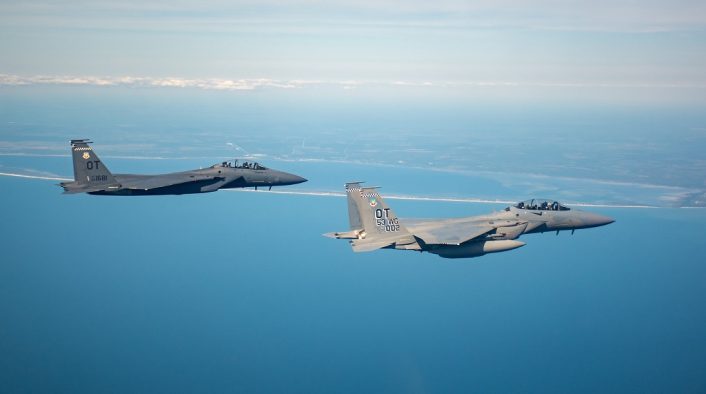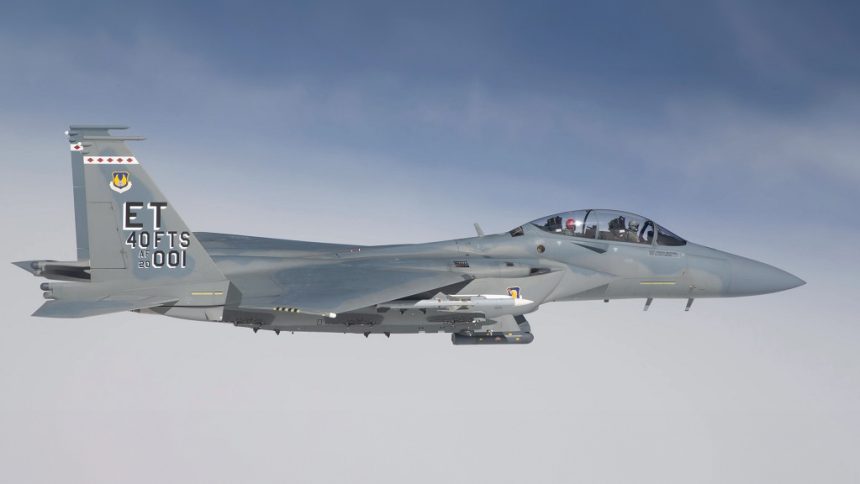EPAWSS provides full-spectrum EW capabilities, including radar warning, geolocation, situational awareness and self-protection, to the F-15E Strike Eagle and F-15EX Eagle II.
The U.S. Air Force recently completed the Initial Operational Test & Evaluation (IOT&E) of the Eagle Passive Active Warning Survivability System (EPAWSS) for the F-15E Strike Eagle and F-15EX Eagle II. The AN/ALQ-250 EPAWSS, installed from the factory on the F-15EX and currently being retrofitted on a number of F-15Es, provides full-spectrum EW capabilities, including radar warning, geolocation, situational awareness, and self-protection to the F-15.
EPAWSS is fully integrated with radar warning, geo-location and increased chaff and flare capability to detect and defeat surface and airborne threats in signal-dense and highly contested environments. Because of this, the system enables freedom of maneuver and deeper penetration into battlespaces protected by modern integrated air defense systems.
“EPAWSS is a leap in technology, improving the lethality and combat capabilities of the F-15E and F-15EX in contested, degraded environments against advanced threats,” said Maj Bryant “Jager” Baum, EPAWSS Test Director for the Air Force Operational Test & Evaluation Center (AFOTEC). “EPAWSS has set the baseline for EW within the fighter community.”
BAE Systems, the manufacturer of the system, notes EPAWSS is notably smaller and lighter than previous EW systems for the F-15. “EPAWSS was designed for upgradeability and rapid capability insertion,” added Amy Nesbitt, EPAWSS program manager at BAE Systems. “We’re using agile software development to provide iterative upgrades to fielded EW systems—allowing our customers to defeat future electromagnetic threats.”
EPAWSS is fully integrated with radar warning, geo-location and increased chaff and flare capability to detects and defeat surface and airborne threats in signal-dense and highly contested environments, according to BAE Systems. The system is currently not integrated with the AN/AAR-57A(V) Common Missile Warning System (CMWS) designed to detect infrared threats, even if the F-15EX features the same mounting points used for these sensors on the F-15QA and F-15SA.

Chaff and flares capacity has been increased by 50%, with four more dispensers added in the EPAWSS fairings behind the tail fins (two for each fairing), for a total of 12 dispenser housing 360 cartridges. This improvement is important as in modern scenarios chaff and flares are often released preemptively to counter MANPADS (Man Portable Air Defense System), meaning that now the Eagle will have more countermeasures available for a better protection.
EPAWSS also integrates cognitive electronic warfare to better discriminate the signals received by the system. This capability was demonstrated during the Northern Edge 2023 large force exercise test event, which tested EPAWSS’ ability to rapidly respond to previously unencountered electromagnetic threats. The tests challenged the system’s ability to process in-mission sensor data, create exquisite techniques, and optimize waveforms in real time.
“Our close collaboration with the U.S. Air Force allows us to mature EPAWSS cognitive processing capabilities,” said Chip Mosle, program director at BAE Systems. “By incrementally testing and fielding cognitive EW solutions to proven systems such as EPAWSS, we are enabling tactical spectrum overmatch against advanced threats that are unpredictable, evolving, and adaptable.”
In the latest Director, Operational Test & Evaluation report, it is mentioned that EPAWSS replaces three functionally obsolete F-15 legacy Tactical Electronic Warfare System components: the AN/ALR-56C Radar Warning Receiver, the AN/ALQ-135 Internal Countermeasures Set, and the AN/ALE-45 Countermeasures Dispenser Set. The system also integrates with the F-15 AN/APG-82(V)1 radar and Advanced Display Core Processor II mission computer.
The first modifications for the F-15E, specifically an aircraft from the 48th Fighter Wing based at RAF Lakenheath, UK, began in May 2023 and the aircraft is expected to return to its unit by 2QFY24. In total, the Air Force plans to retrofit 99 F-15Es and equip all F-15EXs with EPAWSS.









